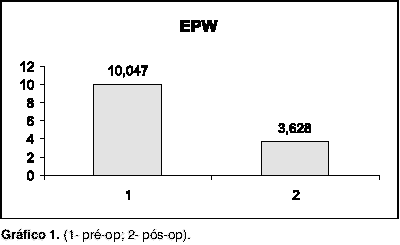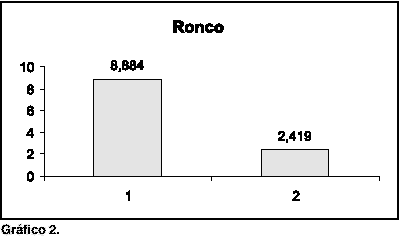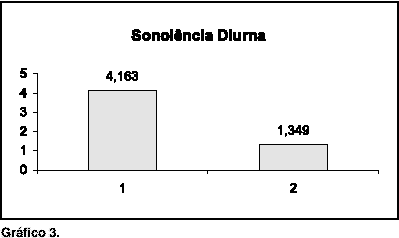INTRODUCTIONSnoring is a medical and social issue that may affect 5% to 50% of the population and tends to increase with age. Seventy-seven percent of the snoring patients do not know they snore and are not aware of the possible systemic abnormalities they may have1.
People who snore are more likely to have hypertension, cerebral vascular accidents and angina pectoris, when compared to age and weight matches that do not snore2.
The most advanced stage of snoring is Obstructive Sleep Apnea Syndrome (OSAS) that causes severe cardiac, pulmonary and behavioral problems.
OSAS affects 2% of the adult female population and 4% of the male population3. The noise of snoring and OSAS originate from the collapse of the upper airways, specially the soft palate, uvula, tonsil and tonsillar pillars and base of the tongue. Primary snoring is defined as low frequency noise produced during sleep by the vibration of uvula and palate.
The treatment of snoring is based on excluding the vibration source by adopting weight loss techniques or surgical intervention. In cases of snoring and mild sleep apnea, one option is Laser Assisted Uvulopalatoplasty (LAUP)4.
LAUP with CO2 laser is a widely used technique, performed under local anesthesia5. The laser vaporizes the tissues thanks to its thermal action, reaching a temperature of 900o C, leading to vaporization of cellular water, protein precipitation and hemostasis of vessels that are as small as 0.5mm, followed by minimal or no postoperative bleeding. Since the laser vaporizes the tissue, pain is an expected factor, as a result of the destruction of tissues.
OBJECTIVEThe present study intends to analyze the selection criteria and the postoperative outcomes of patients submitted to LAUP with CO2 laser, analyzing improvement of clinical presentation using the parameters of Epworth and Stanford scales (snoring and diurnal sleepiness).
MATERIAL AND METHODWe selected 44 patients who had primary snoring and nine of them had mild obstructive sleep apnea, all of them patients from the ambulatory of Snore and Apnea of the Service of Otorhinolaryngology, Hospital das Clínicas, Medical School of Ribeirão Preto-USP. They were submitted to LAUP with CO2 laser between January 1998 and March 2000.
As the parameters to quantify the clinical presentation, we considered the scales of Epworth and Stanford (snore and diurnal sleepiness). Stanford scale is used to assess snoring by employing a 0 to 10 score according to the intensity of the snore reported by family members, considering if it is necessary to sleep in separate rooms or if the patient disturbs people in other rooms. Stanford scale for day sleepiness subjectively quantifies, from 1 to 10, the need to sleep and the frequency the patient sleeps during the day.
In the studied patients, 35 males and 9 females, ages ranging from 21 to 72 years, mean age of 35 years, the main complaint was snore (100%) and mild sleep apnea (20.5%) and during physical examination we visualized elongated uvula, flaccid and lowered palate. In all patients, we conducted Muller's maneuver that consists of visualizing through flexible nasofiberscope the simulation of snoring in the oropharynx and hypopharyx.
We excluded patients who presented secondary causes of snoring and nasal or hypopharynx obstruction. The patients with Epworth scale score equal or greater than 14 were submitted to polysomnography to exclude moderate or severe obstructive sleep apnea or central disorders.
The procedure was performed with the patient in seated position, with topical anesthesia of xilocaine 10% and infiltration with lidocaine 2% with vasoconstrictor in the uvula and soft palate. We used the technique of vaporizing the uvula, making two lateral fissures on the palate, one on each side, approximately 1.5cm in size, to increase soft palate tension. We used potency of 15-20watts for 20 minutes. Patients were followed up for a mean period of one month, when the comparisons were made.
In the postoperative assessment, we found clinical improvement by comparing the scores in Epworth and Stanford scales (snore and diurnal sleepiness). We also conducted chi-square test analysis to statistically confirm data reliability.
RESULTSOf the 44 performed surgeries with mean postoperative follow up of one month, there was 76% of snoring improvement. Epworth scale reduced on average from 10 to 3 (Graph 1). Stanford scale for snore reduced on average from 8 to 2 (Graph 2) and for diurnal sleepiness from 4 to 1 (Graph 3). All patients had positive Muller maneuver in the oropharynx when lying down and only seven people (1.6%) presented positive Muller in the oropharynx when seated. Based on Epworth scale, 12 patients (27%) performed polysomnography and nine of them (75%) presented mild apnea. There was a male/female ratio of approximately 4:1.
DISCUSSIONKamami6, in a 5-year study analyzing 46 patients noticed improvement of at least 50% in the parameters assessed in 87% of the patients.
Mickelson7 had reduction in the respiratory disorder index for 10 or more in 44.4% of the patients.
Krespi8 managed to obtain 85% of reduction or elimination of snoring in 450 patients submitted to 1000 procedures.
Snoring and OSAS depend on the anatomical or functional relation between skeletal abnormalities and upper airways soft tissues9. Many studies have already demonstrated that the site of the OSAS obstruction is somewhere between the nasopharynx and the supraglottic space10, 11. The region of collapse and the mechanism vary in each patient.
The success or failure in any form of snoring and OSAS treatment depends on the correct preoperative assessment and the determination of the mechanism responsible for the problem12.
Clinical history, Epworth and Stanford scales, Muller maneuvers and polysomnography may be used in preoperative assessment of patients with snoring and apnea, constituting a significant part of decision-making process concerning the surgical technique to be employed, which largely influence the results.
The Epworth score presents correlation with respiratory disorder indexes obtained in the polysomnography, however, we should remember that there may be differences between subjective assessments and objective tests13.
The assessment with flexible fiberscope when the patient is awaken, using Muller's maneuver, is a technique that may provide information concerning dynamics and site of obstruction14, helping with the therapeutic decision.
According to Krespi4, endoscopic assessment with Muller's maneuver and polysomnography are determinants for the selection of patients that benefit from LAUP.
In the present study, upon analyzing the results, we noticed a strong correlation between clinical improvement and improvement obtained in the subjective scales as assessment parameters, which reinforced the importance of selecting patients correctly and adopting these scales as part of the subjective parameters. Nevertheless, as mentioned by Alóe1, polysomnography is still the objective test to be used in the analysis of the results.
The absence of patients with moderate and severe apnea, as well as those with skeletal abnormalities, is the result of appropriate preoperative evaluation, contributing to the positive results obtained, since those patients do not benefit from this kind of procedure.
According to Kamami5, it is difficult to maintain good long-term results after the surgery with LAUP to treat apnea and snoring, and in many occasions patients experience recurrence of symptoms and require new intervention. The advantage of using such procedure is that it is quick, easy to perform and can be conducted in the ambulatory under local anesthesia.
In the present study, the follow up was very brief and limited to the conclusion about the results of the surgery. Further assessments are required to check if the good results were maintained.

Graph 1. (1- pre-op; 2- post-op).

Graph 2.

Graph 3.
Epworth and Stanford scales for snore and diurnal sleepiness showed improvement, comparing the results before and after the procedure, reflecting clinical improvement. The differences in results were statistically significant.
The selection of patients based on physical examination, Epworth scale, Muller's maneuver and polysomnography, in indicated cases, proved to be efficient through the positive outcomes obtained.
If properly indicated, LAUP is advantageous because it is a quick procedure performed under local anesthesia and in the ambulatory, allowing for repetition of the procedure.
When indicating LAUP, it is important to exclude those patients with moderate and severe apnea and central disorders since they do not benefit from the procedure.
EPWORTH SCALE

Snore Scale (Stanford)
0= No snoring
1-3 = Mild snore (does not interrupt spouse during sleep)
4-6 = Loud snore (sufficiently loud to disturb spouse)
7-9 = Very loud snore (sufficiently loud to disturb those who are in other rooms)
10 = Spouse leaves the room
Diurnal Sleepiness Scale (Stanford)
0 = Never sleeps during the day
1-3 = Occasionally sleeps during the day
4-6 = Frequently sleeps during the day
7-9 = Sleeps continuously during the day
10 = Constant sleepiness
REFERENCES1. Alóe F. Distúrbio respiratório sono-dependente. In: Pinto JA. Ronco e Apnéia do sono. Rio de Janeiro: Revinter; 1999. cap.5, 21-32.
2. Hassan N, Fletcher EC. Upper airway resistance syndrome. J Kentucky Med Assoc 1994;96(7):261-263.
3. Kyser S, Charuzi I. Obstructive sleep apnea in the obese. Word J Surg 1998;22(9):998-1001.
4. Krespi Y. Laser Assisted Uvulopalatoplasty for the treatment of snoring operative technique in otolaryngology. Head and Neck Surgery 1994;5(4):228-234.
5. Kamami Y. Outpatient treatment of snoring with CO2 laser. The Journal of Otolaryngology 1994;23(6):391-394.
6. Kamami YV. Outpatient treatment of sleep apnea syndrome with CO2 laser. J Clin Laser Med Surg 1994;12(4):215-9.
7. Mickelson AS, Ahuda. Short-term objective and long-term subjective results of LAUP for obstructive sleep apnea. Laryngoscope 1999;109(3):362-7.
8. Krespi, YP. Eficácia da laup no tratamento da SAOS. Ronco e Apnéia do Sono. Ed. Revinter; 2000. p.124-133.
9. Aron S. Otorhinolaryngologic clinics of North America 1990;23(4).
10. Borowiecki BP. Fiber optic study of pharyngeal airway during sleep in patients with hypersomnia obstructive sleep-apnea syndrome. Laryngoscope 1978;88:1310-1313.
11. Guilleminault C, Hill MW, Simmons FB et al. Obstructive sleep apnea, electromyography and fiber studies. Exp Neurol 1978;62:48-67.
12. Sher AE. Endoscopic observation of obstructive sleep apnea in children with anomalous upper airway. Int j. Pediatric otorhinolaryngol 1986;11:135-146.
13. Mendelson WB. Sleepiness and hypertension in obstructive sleep apnea. Chest 1992;101:903-909.
14. Sher AE. Predictive value of Muller maneuver in selection of patients for UPPP. Laryngoscope 1985;95:1483-1487.
1 Resident physician, Discipline of Otorhinolaryngology, Hospital das Clínicas, Medical School, Ribeirão Preto-USP.
2 Assistant physician, Discipline of Otorhinolaryngology, Hospital das Clínicas, Medical School, Ribeirão Preto-USP.
3 Faculty Professor, Head of the Department of Ophthalmology and Otorhinolaryngology, Hospital das Clínicas, FMRP-USP
Department of Ophthalmology and Otorhinolaryngology, Hospital das Clínicas, FMRP-USP
Address correspondence to: Av. dos Bandeirantes, 3900 - CEP 14096-900 Ribeirão Preto - SP - Tel.: (55 16) 602.2523 - Fax: (55 16) 633.0186.
Article submitted on May 24, 2001. Article accepted on February 7, 2002.


